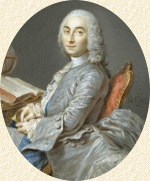|
Jean-Marc Nattier, who was taught by his father, was an eminent portrait painter of the French Rococo.
Born on March 17, 1685 in Paris.
Died on November 07, 1766 in Paris.
In the 18th century, Jean-Marc Nattier was one of the painters who led the French portrait painting scene to a new renaissance. At a young age, he already copied works of Peter Paul Ruben and other masters of the Baroque and received academic awards, being just 15 years old. The colorful, vibrant painting style of this artist appears logical considering these idols. In addition, Natier's high degree of recognition was reflected by orders originating from the Russian royal family and French aristocratic women. In addition, the king's mistresses were partly depicted by him in a mythological disguise. One example for this is the work titled "The Duchess of Chaulines as a Hebe". It was just for these intellectual allusions, although they very were popular in that time, for which Jean-Marc Nattier also experienced a lot of criticism. Very different from the portraits of the late Baroque period, the work called "Queen Mary Leczinska" appeared. It was created in 1748. Without great royal pomp, the artist depicted Louis XV's wife, looking up from her reading, looking at the viewer. The great vitality of expression and color and the depiction in moderate aristocratic clothes were characteristic for the portrait art of his time, besides the presentation of the portrayed person performing everyday actions. |
 |
|
|